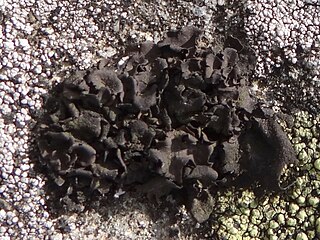
Umbilicaria polyphylla, commonly known as petaled rock tripe, is a widely distributed species of saxicolous lichen in the family Umbilicariaceae. It was first described by Carl Linnaeus in his 1753 work Species Plantarum as Lichen polyphyllus. German botanist Johann Christian Gottlob Baumgarten transferred it to the genus Umbilicaria in 1790. The lichen has a dark brown to black thallus that measures 2–6 cm (0.8–2.4 in) in diameter. The upper surface is smooth, while the lower surface is sooty black. It grows on exposed rocks, typically in arctic-alpine habitats.

Umbilicaria deusta, commonly known as peppered rock tripe, is a widely distributed species of saxicolous lichen in the family Umbilicariaceae. It was first described by Carl Linnaeus in his 1753 work Species Plantarum as Lichen polyphyllus. German botanist Johann Christian Gottlob Baumgarten transferred it to the genus Umbilicaria in 1790. The lichen has a dark brown to nearly black thallus that typically measures 1–5 cm (0.4–2.0 in) in diameter. The upper surface is covered with tiny black dots that are granular isidia; the lower surface is the same colour as the upper surface, and is either smooth or covereds with dimples. It grows on exposed boulders and rocky outcrops.

Malmidea attenboroughii is a species of corticolous (bark-dwelling), crustose lichen in the family Malmideaceae. It is known to occur from a single location in the Amazon rainforest of Bolivia.

Umbilicaria virginis, commonly known as the blushing rock tripe, is a species of saxicolous (rock-dwelling) umbilicate lichen in the family Umbilicariaceae. It occurs in polar and alpine regions.
Waynea cretica is a species of corticolous (bark-dwelling), squamulose lichen in the family Ramalinaceae. It occurs on the Greek island of Crete and in Portugal.
Umbilicaria murihikuana is a rare species of saxicolous (rock-dwelling) lichen in the family Umbilicariaceae. It is endemic to New Zealand, where it occurs in mountainous, high-rainfall areas of Otago and Southland. It grows on exposed rocks and boulders at altitudes between 1,000 and 1,500 m, in subalpine to alpine habitats.
Aspiciliopsis is a genus of lichen-forming fungi in the family Trapeliaceae. It has two species, both of which occur in the Southern Hemisphere.
Lecidea lygommella is a species of saxicolous (rock-dwelling), crustose lichen in the family Lecideaceae. It spreads up to 7 cm wide with a thin thallus varying in colour from whitish and pale grey to rusty red-brown, featuring areolate surfaces with irregularly shaped areoles. Its fruiting bodies range from slightly embedded to sitting atop the thallus and black, flat to slightly convex apothecial discs. Unlike its lookalike Lecidea lygomma, L. lygommella does not produce any secondary chemicals. It is found in New South Wales and Victoria, Australia, where it grows on rocks in alpine areas.
Malmidea allopapillosa is a species of corticolous (bark-dwelling), crustose lichen in the family Malmideaceae. It is found in Venezuela.
Malmidea hernandeziana is a little-known species of corticolous (bark-dwelling), crustose lichen in the family Malmideaceae. It is found in Venezuela. The distinctive features of this species include a thallus with coralloid-like outgrowths, light-coloured fruiting bodies (ascomata) with a specialised structural layer, relatively large spores that tend to have slightly thickened walls at their ends, and the absence of specific lichen products typically found in other species of the genus. This combination of characteristics sets Malmidea hernandeziana apart from other species in the genus Malmidea.
Malmidea isidiifera is a species of corticolous (bark-dwelling), crustose lichen in the family Malmideaceae. It is found in Brazil and Venezuela.
Malmidea leucopiperis is a species of corticolous (bark-dwelling), crustose lichen in the family Malmideaceae. It is found in Brazil.
Malmidea rhodopisoides is a species of corticolous (bark-dwelling), crustose lichen in the family Malmideaceae. It is found in Brazil.
Malmidea subcinerea is a species of corticolous (bark-dwelling), crustose lichen in the family Malmideaceae. It is found in Venezuela. The lichen has a smooth, dull thallus varying in colour from grey to olive, with a white internal medulla. It has sessile, rounded apothecia with light beige to greyish-brown discs.
Byssoloma xanthonicum is a species of corticolous (bark-dwelling), crustose lichen in the family Pilocarpaceae. It is found in New Caledonia.
Erioderma borbonicum is a little-known species of corticolous (bark-dwelling), foliose lichen in the family Pannariaceae. It is endemic to Réunion, an island in the Indian Ocean. The lichen forms a dense, cushion-like thallus with a diameter of 3 to 4 cm, with flat, slightly overlapping lobes with a grey-brown upper surface and cream-coloured underside.
Thelotrema fijiense is a little-known species of corticolous (bark-dwelling), crustose lichen in the family Graphidaceae. It is known from Fiji.
Caloplaca lecanorocarpa is a species of saxicolous (rock-dwelling), crustose lichen in the family Teloschistaceae. Found in Brazil, it was formally described as a new species in 2016 by the lichenologists André Aptroot and Marcela Cáceres. It is named for its overall appearance to lichens in the Lecanora subfusca species complex.
Caloplaca himalayana is a species of lignicolous (wood-dwelling) crustose lichen belonging to the family Teloschistaceae. Found in the Himalayas of India, it was described as new to science in 2009. The lichen has a yellowish thallus with rusty red apothecial discs.

Baeomyces heteromorphus is a species of terricolous (ground-dwelling) lichen in the family Baeomycetaceae. It has an Australasian distribution. Characteristics of the lichen include its greenish-grey thallus, the pink to brownish discs of its apothecia, translucent spores lacking internal partitions (septa), and the presence of the secondary metabolites norstictic acid and connorstictic acid.




